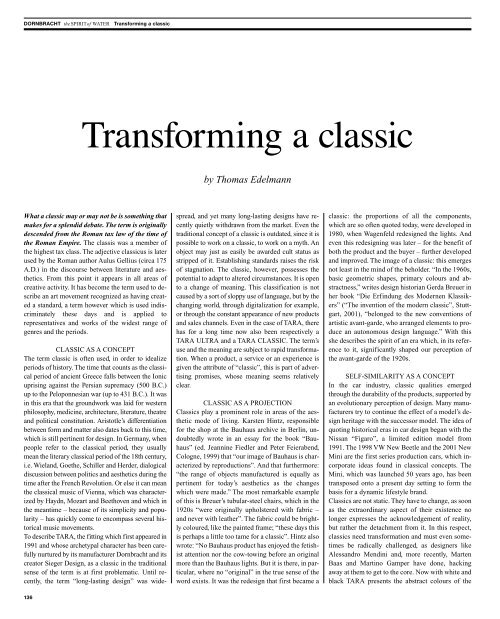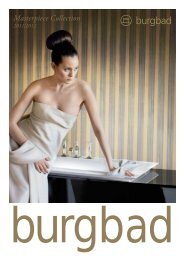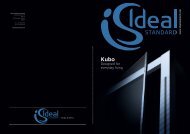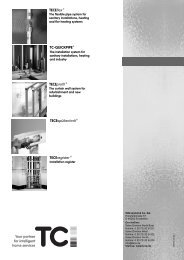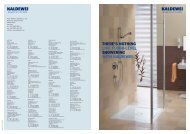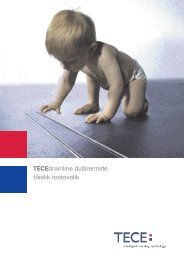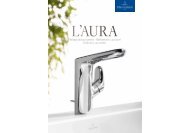productos Dornbracht
productos Dornbracht
productos Dornbracht
You also want an ePaper? Increase the reach of your titles
YUMPU automatically turns print PDFs into web optimized ePapers that Google loves.
DORNBRACHT the SPIRITof WATER Transforming a classic<br />
DORNBRACHT the SPIRITof WATER Transforming a classic<br />
Transforming a classic<br />
What a classic may or may not be is something that<br />
makes for a splendid debate. The term is originally<br />
descended from the Roman tax law of the time of<br />
the Roman Empire. The classis was a member of<br />
the highest tax class. The adjective classicus is later<br />
used by the Roman author Aulus Gellius (circa 175<br />
A.D.) in the discourse between literature and aesthetics.<br />
From this point it appears in all areas of<br />
creative activity. It has become the term used to describe<br />
an art movement recognized as having created<br />
a standard, a term however which is used indiscriminately<br />
these days and is applied to<br />
representatives and works of the widest range of<br />
genres and the periods.<br />
by Thomas Edelmann<br />
CLASSIC AS A CONCEPT<br />
The term classic is often used, in order to idealize<br />
periods of history. The time that counts as the classical<br />
period of ancient Greece falls between the Ionic<br />
uprising against the Persian supremacy (500 B.C.)<br />
up to the Peloponnesian war (up to 431 B.C.). It was<br />
in this era that the groundwork was laid for western<br />
philosophy, medicine, architecture, literature, theatre<br />
and political constitution. Aristotle’s differentiation<br />
between form and matter also dates back to this time,<br />
which is still pertinent for design. In Germany, when<br />
people refer to the classical period, they usually<br />
mean the literary classical period of the 18th century,<br />
i.e. Wieland, Goethe, Schiller and Herder, dialogical<br />
discussion between politics and aesthetics during the<br />
time after the French Revolution. Or else it can mean<br />
the classical music of Vienna, which was characterized<br />
by Haydn, Mozart and Beethoven and which in<br />
the meantime – because of its simplicity and popularity<br />
– has quickly come to encompass several historical<br />
music movements.<br />
To describe Tara, the fitting which first appeared in<br />
1991 and whose archetypal character has been carefully<br />
nurtured by its manufacturer <strong>Dornbracht</strong> and its<br />
creator Sieger Design, as a classic in the traditional<br />
sense of the term is at first problematic. Until recently,<br />
the term “long-lasting design” was widespread,<br />
and yet many long-lasting designs have recently<br />
quietly withdrawn from the market. Even the<br />
traditional concept of a classic is outdated, since it is<br />
possible to work on a classic, to work on a myth. An<br />
object may just as easily be awarded cult status as<br />
stripped of it. Establishing standards raises the risk<br />
of stagnation. The classic, however, possesses the<br />
potential to adapt to altered circumstances. It is open<br />
to a change of meaning. This classification is not<br />
caused by a sort of sloppy use of language, but by the<br />
changing world, through digitalization for example,<br />
or through the constant appearance of new products<br />
and sales channels. Even in the case of TARA, there<br />
has for a long time now also been respectively a<br />
TARA ULTRA and a TARA CLASSIC. The term’s<br />
use and the meaning are subject to rapid transformation.<br />
When a product, a service or an experience is<br />
given the attribute of “classic”, this is part of advertising<br />
promises, whose meaning seems relatively<br />
clear.<br />
CLASSIC AS A PROJECTION<br />
Classics play a prominent role in areas of the aesthetic<br />
mode of living. Karsten Hintz, responsible<br />
for the shop at the Bauhaus archive in Berlin, undoubtedly<br />
wrote in an essay for the book “Bauhaus”<br />
(ed. Jeannine Fiedler and Peter Feierabend,<br />
Cologne, 1999) that “our image of Bauhaus is characterized<br />
by reproductions”. And that furthermore:<br />
“the range of objects manufactured is equally as<br />
pertinent for today’s aesthetics as the changes<br />
which were made.” The most remarkable example<br />
of this is Breuer’s tubular-steel chairs, which in the<br />
1920s “were originally upholstered with fabric –<br />
and never with leather”. The fabric could be brightly<br />
coloured, like the painted frame; “these days this<br />
is perhaps a little too tame for a classic”. Hintz also<br />
wrote: “No Bauhaus product has enjoyed the fetishist<br />
attention nor the cow-towing before an original<br />
more than the Bauhaus lights. But it is there, in particular,<br />
where no “original” in the true sense of the<br />
word exists. It was the redesign that first became a<br />
classic: the proportions of all the components,<br />
which are so often quoted today, were developed in<br />
1980, when Wagenfeld redesigned the lights. And<br />
even this redesigning was later – for the benefit of<br />
both the product and the buyer – further developed<br />
and improved. The image of a classic: this emerges<br />
not least in the mind of the beholder. “In the 1960s,<br />
basic geometric shapes, primary colours and abstractness,”<br />
writes design historian Gerda Breuer in<br />
her book “Die Erfindung des Modernen Klassikers”<br />
(“The invention of the modern classic”, Stuttgart,<br />
2001), “belonged to the new conventions of<br />
artistic avant-garde, who arranged elements to produce<br />
an autonomous design language.” With this<br />
she describes the spirit of an era which, in its reference<br />
to it, significantly shaped our perception of<br />
the avant-garde of the 1920s.<br />
SELF-SIMILARITY AS A CONCEPT<br />
In the car industry, classic qualities emerged<br />
through the durability of the products, supported by<br />
an evolutionary perception of design. Many manufacturers<br />
try to continue the effect of a model’s design<br />
heritage with the successor model. The idea of<br />
quoting historical eras in car design began with the<br />
Nissan “Figaro”, a limited edition model from<br />
1991. The 1998 VW New Beetle and the 2001 New<br />
Mini are the first series production cars, which incorporate<br />
ideas found in classical concepts. The<br />
Mini, which was launched 50 years ago, has been<br />
transposed onto a present day setting to form the<br />
basis for a dynamic lifestyle brand.<br />
Classics are not static. They have to change, as soon<br />
as the extraordinary aspect of their existence no<br />
longer expresses the acknowledgement of reality,<br />
but rather the detachment from it. In this respect,<br />
classics need transformation and must even sometimes<br />
be radically challenged, as designers like<br />
Alessandro Mendini and, more recently, Marten<br />
Baas and Martino Gamper have done, hacking<br />
away at them to get to the core. Now with white and<br />
black TARA presents the abstract colours of the<br />
1960s, rediscovering a new avant-garde for us and<br />
allowing us to emerge from it ourselves altered.<br />
Cos’è e cosa non è un classico può essere un<br />
ottimo argomento di discussione. Il concetto trae<br />
origine dal diritto tributario romano dell’epoca<br />
imperiale. Il “classis”era un appartenente alla<br />
fascia tributaria massima. L’aggettivo classicus<br />
viene poi trasposto nel discorso letterario estetico<br />
dallo scrittore romano Aulus Gellius (intorno al<br />
175 d.C.). Da qui si propaga in tutti i campi<br />
dell’attività creativa, diventando la denominazione<br />
di un’epoca artistica riconosciuta come dettante<br />
norma, di cui nel frattempo si fa un uso inflazionistico,<br />
e applicata a esponenti e opere di<br />
generi e periodi più svariati.<br />
Tara. Black Edition<br />
CLASSICISMO, UN CONCETTO<br />
Il concetto di classico si utilizza spesso per idealizzare<br />
epoche storiche. Come età classica dell’antica<br />
Grecia si considera il lasso di tempo compreso tra<br />
l’insurrezione ionica contro il dominio persiano (500<br />
a.C.) e la guerra del Peloponneso (fino al 431 a.C.).<br />
In quest’epoca si gettarono le basi della filosofia<br />
occidentale, della medicina, dell’architettura, della<br />
letteratura, del teatro e dell’ordinamento politico. A<br />
questo periodo risale anche la distinzione di Aristotele<br />
tra forma e materia che riveste non poca importanza<br />
perfino nel design. Se si parla di epoca classica<br />
in Germania, allora il discorso verte sul classicismo<br />
letterario del XVIII secolo, su Wieland, Goethe,<br />
Schiller ed Herder, sul conflitto dialogico con la politica<br />
e l’estetica del periodo successivo alla Rivoluzione<br />
francese. Oppure ci si riferisce al classicismo<br />
musicale viennese che è stato segnato da Haydn,<br />
Mozart e Beethoven e che, come concetto di musica<br />
classica, – perché semplice e popolare - comprende<br />
anche altre epoche storiche dell’articolazione del<br />
suono.<br />
Se Tara, la rubinetteria nata nel 1991 e il cui<br />
carattere archetipo è stato diligentemente curato da<br />
<strong>Dornbracht</strong> come costruttore e da Sieger Design<br />
come ideatore, viene definita un classico, in un<br />
primo momento può sembrare problematico, se<br />
inteso nel senso tramandato del concetto. Fino a<br />
poco tempo fa era diffusa l’espressione “design<br />
longevo”, ma molti progetti longevi negli ultimi<br />
anni si sono congedati dal mercato senza far rumore.<br />
Il concetto stesso di classico tramandatoci dal<br />
passato è superato. Allora lavorare sul classicismo,<br />
lavorare sul mito è possibile. Il cult può affermarsi<br />
e poi scomparire, gli standard celano il rischio della<br />
stagnazione. Il classico invece possiede il potenziale<br />
dell’adattamento a nuove condizioni. È aperto<br />
ai mutamenti di significato. La causa della classificazione<br />
non risiede in un uso linguistico impreciso,<br />
ma nel cambiamento che il mondo ha subito ad<br />
esempio ad opera della digitalizzazione, di prodotti<br />
e canali di vendita sempre nuovi. Anche nel caso<br />
di TARA esiste da tempo una TARA ULTRA e,<br />
logicamente, una TARA CLASSIC. L’uso e il contenuto<br />
del concetto dipendono da cambiamenti<br />
rapidi. L’attributo che definisce un prodotto, un<br />
servizio o un avvenimento come classico rientra in<br />
quelle promesse pubblicitarie, il cui significato<br />
sembra relativamente chiaro.<br />
CLASSICISMO, UNA PROIEZIONE<br />
I classici giocano un ruolo di rilievo nell’estetizzazione<br />
della vita pratica. Karsten Hintz, responsabile dello<br />
shop del Bauhaus Archiv di Berlino, in un contributo<br />
alla pubblicazione “Bauhaus” (a cura di Jeannine<br />
Fiedler e Peter Feierabend, Colonia 1999), scrive in<br />
modo inequivocabile “la nostra immagine del Bauhaus<br />
è fortemente influenzata dalle imitazioni”. E<br />
ancora: “La scelta degli oggetti prodotti ha a che fare<br />
con la nostra estetica attuale, esattamente come le variazioni<br />
apportate.” Il caso più eclatante sono le sedie<br />
in acciaio tubolare di Breuer che, negli anni Venti,<br />
“originariamente erano rivestite in stoffa – e non in<br />
pelle”. Essa poteva essere molto colorata come il telaio<br />
laccato; “oggi forse troppo modesta e vivace per un<br />
classico”. Hintz prosegue: “Nessun prodotto del Bauhaus<br />
è più esposto delle luci al feticismo e alla genuflessione<br />
all’originale come le lampade Bauhaus. Ma<br />
“la lampada Bauhaus” originale non esiste. Ciò che è<br />
diventato un classico è il re-design: la proporzione di<br />
tutti i componenti, oggi molto citata, è stata sviluppata<br />
nel 1980, quando Wagenfeld rielaborò la lampada.”<br />
E la stessa rielaborazione è poi stata nuovamente modificata<br />
e migliorata – per il bene del prodotto e dei<br />
suoi acquirenti. L’immagine del classico nasce, non da<br />
ultimo, nella testa dell’osservatore. “Forme di base<br />
geometriche, colori primari e inutilità”, scrive la storica<br />
del design Gerda Breuer nel suo testo “Die Erfindung<br />
des Modernen Klassikers” (Stoccarda, 2001),<br />
“rientravano tra le nuove convenzioni dell’avanguardia<br />
artistica degli anni Sessanta che definiva gli elementi<br />
per un linguaggio delle forme autonomo”. Descrive<br />
quindi lo spirito di un’epoca che ha influenzato<br />
in modo determinante la nostra immagine dell’avanguardia<br />
degli anni Venti, riferendosi ad essa.<br />
AUTOSOMIGLIANZA, UN CONCETTO<br />
Nell’industria automobilistica, le qualità del classico<br />
sono cresciute dalla solidità dei prodotti, supportata<br />
da un’interpretazione rivoluzionaria del design.<br />
Molti costruttori tentano di far rivivere l’eredità creativa<br />
di un modello in quello successivo. Con Nissan<br />
“Figaro” – un’edizione limitata del 1991 – è<br />
nata l’idea di citare epoche storiche nel design automobilistico.<br />
La VW New Beetle del 1998 e la New<br />
Mini del 2001 sono le prime serie di auto che prendono<br />
in prestito progetti classici. La Mini, nata<br />
50 anni fa, oggi è stata trasformata come base di un<br />
marchio dinamico di lifestyle.<br />
I classici non sono affatto statici, essi devono modificarsi,<br />
non appena la loro esistenza straordinaria<br />
non suscita più approvazione, ma distacco dalla realtà.<br />
A quel punto i classici necessitano di trasformazione,<br />
talvolta anche di una radicale messa in<br />
discussione, linea perseguita da designer come<br />
Alessandro Mendini e in tempi recenti Marten Baas<br />
e Martino Gamper che li hanno incalzati con fuoco<br />
e sega. Così ora TARA inscena con il bianco e il<br />
nero i colori non concreti degli anni Sessanta, restituendoci<br />
una nuova avanguardia e facendone risultare<br />
la nostra evoluzione.<br />
136<br />
137


